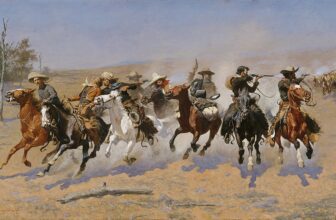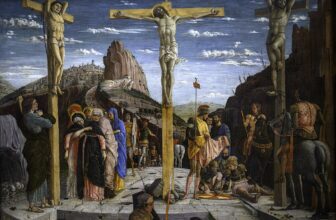
Self Portrait with Halo and Snake Meaning
Self-Portrait with Halo and Snake is a famous painting by French artist Paul Gauguin, created in 1889. This self-portrait is rich in symbolism, reflecting Gauguin’s complex identity, inner struggles, and artistic vision. The painting features Gauguin’s face surrounded by a glowing halo, a reference to religious imagery, hinting at his self-perception as a visionary or even a martyr of art. However, the presence of the snake, often associated with temptation and sin, adds a duality to the composition, suggesting a struggle between virtue and vice. The bold colors and expressive brushwork enhance the painting’s emotional depth. Gauguin, known for his rejection of conventional society, often depicted himself in ways that challenged traditional self-portraits. Self-Portrait with Halo and Snake serves as a deeply personal statement, encapsulating his artistic rebellion, spiritual introspection, and the complex relationship between good and evil within his own psyche.
Paul Gauguin’s “Self-Portrait with Halo and Snake”
Paul Gauguin, celebrated as one of the pioneers of Post-Impressionism and a leading figure in the Symbolist movement, is renowned for his innovative use of color, form, and symbolism to express complex ideas and emotions. Among his most enigmatic works is the “Self-Portrait with Halo and Snake,” a captivating canvas that offers viewers a glimpse into the artist’s psyche and creative vision. Painted in 1889, during Gauguin’s sojourn in Tahiti, this masterpiece combines elements of autobiography, mythology, and spirituality to create a deeply personal and introspective portrait.
At first glance, Gauguin’s self-portrait appears to be a straightforward representation of the artist himself. He stands before the viewer with a solemn expression, his gaze fixed in the distance with a sense of quiet intensity. His features are rendered with Gauguin’s characteristic boldness and simplicity, capturing the essence of the man behind the canvas. Yet, it is the presence of the halo and snake that imbues the painting with a sense of mystery and intrigue, hinting at deeper layers of meaning beneath the surface.
The halo hovering above Gauguin’s head is a potent symbol of divinity and enlightenment, traditionally associated with saints, angels, and other holy figures in Christian iconography. Yet, in Gauguin’s self-portrait, the halo takes on a more ambiguous and open-ended meaning. Rather than representing divine grace or spiritual purity, the halo serves as a metaphor for Gauguin’s own artistic vision and creative genius. It illuminates his head like a beacon of light, symbolizing the transcendent power of art to elevate the human spirit and reveal deeper truths about the world.
The snake, coiled around Gauguin’s neck and shoulders, adds another layer of symbolism to the painting. In many cultures and mythologies, the snake is associated with knowledge, wisdom, and transformation—a potent symbol of the mysteries of life and the unconscious mind. In Gauguin’s self-portrait, the snake serves as a metaphor for the artist’s own inner turmoil and existential quest. It whispers secrets of the creative process into Gauguin’s ear, guiding him on a journey of self-discovery and artistic exploration.
Yet, the snake also carries darker connotations, symbolizing the temptations and contradictions of the human experience. In Christian iconography, the snake is often associated with the Fall of Man and the temptation of Eve in the Garden of Eden—a reminder of the inherent frailty and sinfulness of human nature. In Gauguin’s self-portrait, the snake serves as a reminder of the artist’s own struggles with morality, desire, and the pursuit of artistic truth.
The juxtaposition of the halo and snake in Gauguin’s self-portrait creates a tension and ambiguity that reflects the complexities of the artist’s own psyche. Throughout his life, Gauguin grappled with feelings of alienation, disillusionment, and spiritual longing, searching for meaning and purpose in a world that often seemed indifferent and hostile. In “Self-Portrait with Halo and Snake,” Gauguin confronts these existential dilemmas head-on, embracing the contradictions and paradoxes of his own nature with courage and defiance.
What Movement and Style is Self-Portrait with Halo and Snake?
Self-Portrait with Halo and Snake is a prime example of the Post-Impressionist movement and exhibits strong Symbolist influences.
- Post-Impressionism: This movement, which emerged in the late 19th century, was a reaction against the naturalism and realism of Impressionism. Artists like Gauguin, Vincent van Gogh, and Paul Cézanne sought to express deeper emotions and symbolic meanings through color, form, and composition. Unlike the fleeting effects of light that Impressionists captured, Post-Impressionists aimed to create more structured and thought-provoking imagery.
- Symbolism: Gauguin’s self-portrait also aligns with the Symbolist movement, which emphasized the use of mythological, religious, and dream-like imagery. In Self-Portrait with Halo and Snake, Gauguin incorporates a halo and a serpent—both potent symbols in Christian and pagan traditions. The halo represents sanctity or divine inspiration, while the snake, associated with temptation and sin, adds a layer of duality to his self-depiction. This contrast highlights the artist’s inner struggles and the complexities of his personality.
- Cloisonnism and Synthetism: Gauguin’s painting style in this work also reflects the principles of Cloisonnism and Synthetism, which he developed alongside Émile Bernard. Cloisonnism features bold outlines and flat, vibrant color areas, resembling medieval enamelwork or stained glass. Synthetism, on the other hand, emphasizes simplified forms, exaggerated colors, and the artist’s subjective interpretation rather than direct observation.
These stylistic choices make Self-Portrait with Halo and Snake a powerful, introspective work that encapsulates Gauguin’s artistic vision and philosophical beliefs.
How Much is Self-Portrait with Halo and Snake Worth?
As one of Gauguin’s most significant self-portraits, Self-Portrait with Halo and Snake is considered an invaluable piece of art history. Since it is currently housed in the National Gallery of Art in Washington, D.C., and part of a public collection, it is not on the art market and does not have an official price tag. However, based on market trends and recent sales of Gauguin’s works, an estimated valuation can be inferred.
- Auction Prices of Gauguin’s Paintings: Gauguin’s paintings have commanded extraordinary prices at auction. One of his most famous paintings, Nafea Faa Ipoipo (When Will You Marry?), sold for approximately $210 million in a private sale in 2015, making it one of the most expensive paintings ever sold.
- Valuation Estimate: Given the historical significance, symbolic depth, and unique self-representation in Self-Portrait with Halo and Snake, experts estimate that if it were to be sold at auction today, it could fetch anywhere between $100 million and $200 million or more.
- Cultural and Artistic Value: Despite the potential monetary value, institutions like the National Gallery of Art rarely sell masterpieces of this caliber. Instead, the painting is preserved for public viewing, scholarly research, and cultural enrichment.
Gauguin’s works remain in high demand, and his bold approach to color, form, and symbolism continues to influence artists today. If Self-Portrait with Halo and Snake were ever to be placed on the market, it would undoubtedly attract intense interest from collectors, museums, and art investors worldwide.
Where is Self-Portrait with Halo and Snake by Paul Gauguin?
Self-Portrait with Halo and Snake by Paul Gauguin is housed at the National Gallery of Art in Washington, D.C., United States. This striking painting, created in 1889, is part of the museum’s collection and is considered one of Gauguin’s most significant self-portraits. The National Gallery of Art, known for its extensive collection of European and American masterpieces, acquired the painting to showcase the work of one of the most influential Post-Impressionist painters.
Gauguin painted Self-Portrait with Halo and Snake during his stay at the artists’ colony in Le Pouldu, Brittany, France. This period marked a critical phase in his artistic evolution, as he began to develop a more symbolic and spiritual approach to his work. The painting remains a key piece in the National Gallery of Art’s collection and is often displayed in exhibitions focused on Post-Impressionism and Symbolism.
Paul Gauguin’s Self-Portrait with Halo and Snake stands as a profound exploration of identity, spirituality, and artistic rebellion. The painting captures the artist’s self-perception, blending religious iconography with personal symbolism. It reflects his philosophical beliefs, his struggle between virtue and temptation, and his desire to break away from traditional artistic norms.
Today, the painting remains an essential piece of art history, offering viewers insight into the mind of one of the most enigmatic artists of the 19th century. Whether admired for its vibrant colors, symbolic depth, or historical significance, Self-Portrait with Halo and Snake continues to captivate audiences and scholars alike.




